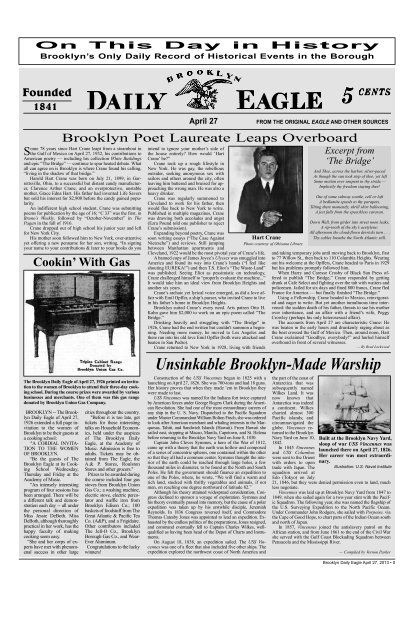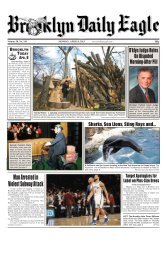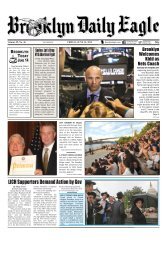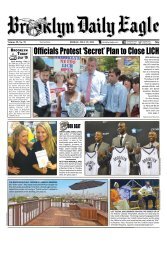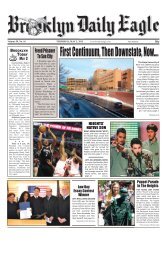April 26 2013 Fri BDE.pdf - Brooklyn Daily Eagle
April 26 2013 Fri BDE.pdf - Brooklyn Daily Eagle
April 26 2013 Fri BDE.pdf - Brooklyn Daily Eagle
Create successful ePaper yourself
Turn your PDF publications into a flip-book with our unique Google optimized e-Paper software.
On This Day in History<strong>Brooklyn</strong>’s Only <strong>Daily</strong> Record of Historical Events in the BoroughFounded1841<strong>April</strong> 27FROM THE ORIGINAL EAGLE AND OTHER SOURCES<strong>Brooklyn</strong> Poet Laureate Leaps OverboardSome 78 years since Hart Crane leapt from a steamboat inthe Gulf of Mexico on <strong>April</strong> 27, 1932, his contributions toAmerican poetry — including his collection White Buildingsand epic “The Bridge” — continue to spur heated debate. Whatall can agree on is <strong>Brooklyn</strong> is where Crane found his calling,“living in the shadow of that bridge.”Harold Hart Crane was born on July 21, 1899, in Garrettsville,Ohio, to a successful but distant candy manufacturer,Clarence Arthur Crane, and an overprotective, unstablemother, Grace Edna Hart. His father had invented Life Saversbut sold his interest for $2,900 before the candy gained popularity.An indifferent high school student, Crane was submittingpoems for publication by the age of 16; “C 33” was the first, inBruno’s Weekly, followed by “October-November” in ThePagan in the fall of 1916.Crane dropped out of high school his junior year and leftfor New York City.His mother soon followed him to New York, over-attentiveyet offering a new penname for her son, writing, “In signingyour name to your contributions & later to your books do youCookin’ With GasThe <strong>Brooklyn</strong> <strong>Daily</strong> <strong>Eagle</strong> of <strong>April</strong> 27, 19<strong>26</strong> printed an invitationto the women of <strong>Brooklyn</strong> to attend their three-day cookingschool. During the course prizes were awarded by variousbusinesses and merchants. One of them was this gas rangedonated by <strong>Brooklyn</strong> Union Gas Company.BROOKLYN -- The <strong>Brooklyn</strong><strong>Daily</strong> <strong>Eagle</strong> of <strong>April</strong> 27,19<strong>26</strong> extended a full page invitationto the women of<strong>Brooklyn</strong> to be their guests ata cooking school:"A CORDIAL INVITA-TION TO THE WOMENOF BROOKLYN.“Be the guests of The<strong>Brooklyn</strong> <strong>Eagle</strong> at its CookingSchool Wednesday,Thursday and <strong>Fri</strong>day at theAcademy of Music."An intensely interestingprogram of four sessions hasbeen arranged. There will bea different talk and demonstrationeach day -- all underthe personal direction ofMiss Jessie DeBoth. MissDeBoth, although thoroughlypractical in her work, has thehappy faculty of makingcooking seem easy.“She and her corps of expertshave met with phenomenalsuccess in other largecities throughout the country."Before it is too late, gettickets for these interestingtalks on Household Economics,held under the auspicesof The <strong>Brooklyn</strong> <strong>Daily</strong><strong>Eagle</strong>, at the Academy ofMusic. Admission is free toadults. Tickets may be obtainedfrom The <strong>Eagle</strong>, theA.& P. Stores, RoulstonStores and other grocers."Prizes to be awarded duringthe course included four gasstoves from <strong>Brooklyn</strong> UnionGas Co.; a washing machine,electric stove, electric percolatorand waffle iron from<strong>Brooklyn</strong> Edison Co.; 100baskets of foodstuff from TheGreat Atlantic & Pacific TeaCo. (A&P), and a <strong>Fri</strong>gidaire.Other contributors includedThe Jell-O Co., <strong>Brooklyn</strong>Borough Gas Co., and Wear-Ever Aluminum.Congratulations to the luckywinners!intend to ignore your mother’s side ofthe house entirely? How would ‘HartCrane’ be?”Crane took up a rough lifestyle inNew York. He was gay, the rebelliousoutsider, seeking anonymous sex withsailors and others around the city, oftenleaving him battered and bruised for approachingthe wrong man. He was also aheavy drinker.Crane was regularly summoned toCleveland to work for his father, thenwould flee back to New York to write.Published in multiple magazines, Cranewas drawing both accolades and angst(Ezra Pound told one publisher to rejectCrane’s submission).Expanding beyond poetry, Crane wassoon writing essays (“The Case AgainstNietzsche”) and reviews. Still jumpingbetween Manhattan apartments andCleveland, 1922 would be the most pivotal year of Crane’s life.A banned copy of James Joyce’s Ulysses was smuggled intoAmerica and found its way into Crane’s hands (“I feel likeshouting EUREKA!”) and then T.S. Eliot’s “The Waste-Land”was published. Seeing Eliot as pessimistic on technology,Crane challenged himself to “properly evaluate the machine...”It would take him an ideal view from <strong>Brooklyn</strong> Heights andanother six years.Crane’s archaic yet lyrical voice emerged, as did a love affairwith Emil Opffer, a ship’s purser, who invited Crane to livein his father’s home in <strong>Brooklyn</strong> Heights.<strong>Brooklyn</strong> suited Crane’s every need. Arts patron Otto H.Kahn gave him $2,000 to work on an epic poem called “TheBridge.”Drinking heavily and struggling with “The Bridge” in19<strong>26</strong>, Crane had the end written but couldn't summon a beginning.Needing more money, he moved to Los Angeles andthere ran into his old love Emil Opffer (both were attacked andbeaten in San Pedro).Crane returned to New York in 1928, living with friendsand taking temporary jobs until moving back to <strong>Brooklyn</strong>, firstto 77 Willow St., then back to 110 Columbia Heights. Wearingout his welcome at the Opffers, Crane headed to Paris in 1929but his problems promptly followed him.When Harry and Caresse Crosby of Black Sun Press offeredto publish “The Bridge,” Crane responded by gettingdrunk at Cafe Select and fighting over the tab with waiters andpolicemen. Jailed for six days and fined 800 francs, Crane fledFrance for America — but finally finished “The Bridge.”Using a Fellowship, Crane headed to Mexico, reinvigoratedand eager to write. But yet another tumultuous time intervened:the sudden death of his father, threats to sue his motherover inheritance, and an affair with a friend’s wife, PeggyCrowley (perhaps his only heterosexual affair).The accounts from <strong>April</strong> 27 are characteristic Crane: Hewas beaten in the early hours and drunkenly raging about asthe boat crossed the Gulf of Mexico. Then, around noon, HartCrane exclaimed “Goodbye, everybody!” and hurled himselfoverboard in front of several witnesses.— By Brad LockwoodUnsinkable <strong>Brooklyn</strong>-Made WarshipConstruction of the USS Vincennes began in 1825 with alaunching on <strong>April</strong> 27, 18<strong>26</strong>. She was 700-tons and had 18 guns.Her history proves that when they made ’em in <strong>Brooklyn</strong> theywere made to last.USS Vincennes was named for the Indiana fort twice capturedby American forces under George Rogers Clark during the AmericanRevolution. She had one of the most extraordinary careers ofany ship in the U. S. Navy. Dispatched to the Pacific Squadronunder Master Commandant William Bolton Finch, she was orderedto look after American merchant and whaling interests in the Marquesas,Tahiti, and Sandwich Islands (Hawaii). From Hawaii shesailed east, stopping at Macao, Manila, Capetown, and St. Helenabefore returning to the <strong>Brooklyn</strong> Navy Yard on June 8, 1830.Captain John Cleves Symmes, a hero of the War of 1812,came up with a theory that the earth was hollow and composedof a series of concentric spheres, one contained within the otherso that they all had a common center. Symmes thought the interiorof the earth could be reached through large holes, a fewthousand miles in diameter, to be found at the North and SouthPoles. He felt the government should finance an expedition toone of the Poles, where, he wrote, “We will find a warm andrich land, stocked with thrifty vegetables and animals, if notmen, on reaching one degree northward of latitude 82.”Although his theory attained widespread consideration, Congressdeclined to sponsor a voyage of exploration. Symmes andhis theory eventually passed into memory, but the cause of a polarexpedition was taken up by his erstwhile disciple, JeremiahReynolds. In 1836 Congress reversed itself, and CommodoreThomas Catesby Jones was appointed to lead an expedition. Exhaustedby the endless politics of the preparations, Jones resigned,and command eventually fell to Captain Charles Wilkes, wellqualifiedas having been head of the Depot of Charts and Instruments.On August 18, 1838, an expedition sailed. The USS Vincenneswas one of a fleet that also included five other ships. Theexpedition explored the northwest coast of North America andHart CranePhoto courtesy of Ohioana Librarythe part of the coast ofAntarctica that wassubsequently namedWilkes Land. It wasnow known thatAntarctica was indeeda continent. Wilkescharted almost 300Pacific islands; andcircumnavigated theglobe. Vincennes returnedto the <strong>Brooklyn</strong>Navy Yard on June 10,1842.In 1845 Vincennesand USS Columbuswere sent to the Orientwith orders to opentrade with Japan. Thesquadron arrived atEdo (Tokyo) on JulyExcerpt from‘The Bridge’And Thee, across the harbor, silver-pacedAs though the sun took step of thee, yet leftSome motion ever unspent in thy stride,—Implicitly thy freedom staying thee!Out of some subway scuttle, cell or loftA bedlamite speeds to thy parapets,Tilting there momently, shrill shirt ballooning,A jest falls from the speechless caravan.Down Wall, from girder into street noon leaks,A rip-tooth of the sky’s acetylene;All afternoon the cloud-flown derricks turn . . .Thy cables breathe the North Atlantic still.Built at the <strong>Brooklyn</strong> Navy Yard,sloop of war USS Vincennes waslaunched there on <strong>April</strong> 27, 18<strong>26</strong>.Her career was most extraordinary.Illustration: U.S. Naval Institute21, 1846, but they were denied permission even to land, muchless negotiate.Vincennes was laid up at <strong>Brooklyn</strong> Navy Yard from 1847 to1849, when she sailed again for a two-year stint with the PacificSquadron. The following year, she was named the flagship ofthe U.S. Surveying Expedition to the North Pacific Ocean.Under Commander John Rodgers, she sailed with Porpoise, viathe Cape of Good Hope, to chart parts of the Indian Ocean southand north of Japan.In 1857, Vincennes joined the antislavery patrol on theAfrican station, and from June 1861 to the end of the Civil Warshe served with the Gulf Coast Blockading Squadron betweenPensacola and the Mississippi River.— Compiled by Vernon Parker6 • <strong>Brooklyn</strong> <strong>Daily</strong> <strong>Eagle</strong> • <strong>April</strong> <strong>26</strong>, <strong>2013</strong><strong>Brooklyn</strong> <strong>Daily</strong> <strong>Eagle</strong> <strong>April</strong> 27, <strong>2013</strong> • 0


